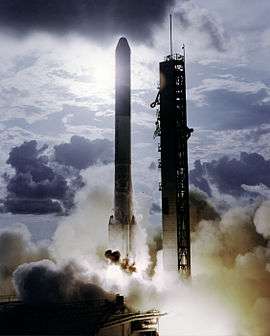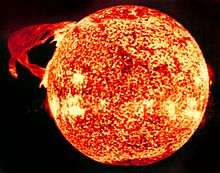Orbiting Solar Observatory



The Orbiting Solar Observatory (abbreviated OSO) Program was the name of a series of eight American science satellites primarily intended to study the Sun, though they also included important non-solar experiments. Eight were launched successfully by NASA between 1962 and 1975 using Delta rockets. Their primary mission was to observe an 11-year sun spot cycle in UV and X-ray spectra. The initial seven (OSO 1–7) were built by Ball Aerospace, then known as Ball Brothers Research Corporation (BBRC), in Boulder Colorado.[1] OSO 8 was built by Hughes Space and Communications Company, in Culver City, California.
Satellite design
The basic design of the entire series featured a rotating section, the "Wheel," to provide gyroscopic stability. A second section, the "Sail," was driven electrically against the Wheel's rotation, and stabilized to point at the Sun. The Sail carried pointed solar instruments, and also the array of solar photovoltaic cells which powered the spacecraft. The critical bearing between the Wheel and the Sail was a major feature of the design, as it had to operate smoothly for months in the hard vacuum of space without normal lubrication. It also carried both the power from the Sail and the data from the pointed solar instruments to the Wheel, where most of the spacecraft functions were located. Additional science instruments could also be located in the Wheel, generally looking out on a rotating radius vector which scanned the sky, and also across the Sun, every few seconds.
Satellite information
| Designation | Launch Date | Re-entry date | Notable results |
|---|---|---|---|
| OSO 1 | 7 March 1962 | 7 October 1981[2] | |
| OSO 2 | 3 February 1965 | 8 August 1989[3] | |
| OSO 3 | 8 March 1967 | 4 April 1982[4] | Observed solar flares from the Sun, as well as a flare from Scorpius X-1[5] |
| OSO 4 | 18 October 1967 | 14 June 1982[6] | |
| OSO 5 | 22 January 1969 | 2 April 1984[7] | Measured diffuse background X-ray radiation from 14-200 keV[8] |
| OSO 6 | 9 August 1969 | 7 March 1981[9] | Observed three instances of hard X-ray coincidences with gamma ray bursts.[10] |
| OSO 7 | 29 September 1971 | 8 July 1974[11] | Observed solar flares in the gamma ray spectrum. Collected data allowed for identification of Vela X-1 as a High-mass X-ray binary.[12] |
| OSO 8 | 21 June 1975 | 8 July 1986[13] | Found an iron emission line in the X-ray spectrum of a galaxy cluster.[14] |
Advanced OSO
The Advanced Orbiting Solar Observatory (AOSO) program was developed in the mid 1960s as a more advanced version of the OSO series. Conceived as a polar-orbiting satellite system, these spacecraft would continuously monitor the Sun and surrounding environment with detectors and electronic imaging ranging from x-rays to visual light. Due to budget constraints, the AOSO program was cancelled in 1965. Instead, it was replaced by the OSO-I, OSO-J and OSO-K satellites. Only OSO-I, which became OSO 8, was ever launched.[15]
See also
References
- ↑ Todd Neff (2010) From Jars to the Stars: How Ball Came to Build a Comet-Hunting Machine Denver, CO.: Earthview Media.
- ↑ "Trajectory Details OSO 1". NASA. Retrieved 5 September 2014.
- ↑ "Trajectory Details OSO 2". NASA. Retrieved 5 September 2014.
- ↑ "Trajectory Details OSO 3". NASA. Retrieved 5 September 2014.
- ↑ "The Third Orbiting Solar Observatory". NASA's Imagine the Universe!. NASA. Retrieved 5 September 2014.
- ↑ "Trajectory Details OSO 4". NASA. Retrieved 5 September 2014.
- ↑ "Trajectory Details OSO 5". NASA. Retrieved 5 September 2014.
- ↑ "The Fifth Orbiting Solar Observatory". NASA's Imagine the Universe!. NASA. Retrieved 5 September 2014.
- ↑ "Trajectory Details OSO 6". NASA. Retrieved 5 September 2014.
- ↑ "The Sixth Orbiting Solar Observatory". NASA's Imagine the Universe!. NASA. Retrieved 5 September 2014.
- ↑ "Trajectory Details OSO 7". NASA. Retrieved 5 September 2014.
- ↑ "The Seventh Orbiting Solar Observatory". NASA's Imagine the Universe!. NASA. Retrieved 5 September 2014.
- ↑ "Trajectory Details OSO 8". NASA. Retrieved 5 September 2014.
- ↑ "The Eighth Orbiting Solar Observatory". NASA's Imagine the Universe!. NASA. Retrieved 5 September 2014.
- ↑ "Advanced OSO". NASA - NSSDC - Spacecraft - Details. NASA. Retrieved 5 September 2014.
External links
- OSO 1 experiments record at National Space Science Data Center
- OSO 1 at NASA's Imagine the Universe

